Banu Gökariksel writes for for ISLAMiCommentary
Fatih neighborhood of Istanbul, 2009. photo by Banu Gökarıksel
The veil is a piece of fabric that is politicized like no other. It is the persistent topic of fiery political debates and possibly the most stigmatized, praised, banned, and enforced article of clothing. And it continues to be one of the most misunderstood, stereotyped, and contested aspects of Muslim identities and politics across the world.
The veil is implicated in a wide range of cultural and (geo) political debates on women’s roles, Islam and Muslim cultures, secularism, democracy, terrorism, and war. In many of these debates, political leaders, pundits, and activists treat the veil as a symbol and speak for and about veiled Muslim women.
But the treatment of the veil as a symbol deprives veiled women of the public recognition of their humanity, with the effect of rendering them less than human in the eyes of some as the veil ‘stands in’ for the women and what they represent to the viewer — whether it is political Islam, the religion of Islam, secular or Islamically-oriented state projects, the Muslim umma, or a newly defined Muslim identity.
The veil often appears a convenient symbol of the Muslim Other to be feared, or alternatively, of the Muslim ideal to be upheld. Although many Muslim women do speak out, their experiences are seldom heard or listened to publicly.
This February the Duke/UNC Consortium for Middle East Studies took on the politically charged topic of veiling at its annual conference with several goals in mind: to examine the persistence of stereotypical representations of the veil; to understand the veil and its multiple meanings, styles, and practices; and to recognize Muslim women as subjects rather than dehumanized objects or icons.
To this end, the ReOrienting the Veil conference brought together an artist/activist and interdisciplinary group of scholars (from Religion, Anthropology, Francophone Studies, Geography, and History) and more than 100 students, university faculty, local K-12 teachers, and community members.
For artist/activist Todd Drake’s collaborative Esse Quam Videri: Muslim-American Self-Portraits project (a collection of images and accompanying essays that appeared at the Ackland Art Museum at UNC-Chapel Hill this winter) veiled women were photographed how they wanted to be viewed, empowered — whether laughing, playing basketball, or standing confidently with tools in hand in a car repair shop. (Conference participants were treated to a personalized tour of these images).
Beyond Stereotypes
While veils come in all colors, sizes, shapes, and designs and are worn on the catwalk, on soccer fields, in classrooms, and on the street, photos of veiled women in mainstream western media or on popular book covers often portray the veil as a prison, (as in this one by French cartoonist Plantu), and veiled women often appear as solemn, sad, and victimized, if not ominous and threatening, explained Typhaine Lservot, Associate Professor in the Romance Languages and Literature Department and College of Letters at Wesleyan University.
Lservot devoted most of her presentation to an analysis of how the veil and veiled women were depicted in political cartoons at the height of the ‘burqa affair’ in France.
France is an important context for the analysis of the veil because of its history as a colonial power and exporter of negative images of Islam and the veil. France has taken aggressive steps to regulate the veil in its different forms, first banning the headscarf in schools in 2004 and then, after much public debate beginning in 2008, banning the niqab (face covering) from all public spaces in 2011. (The latter was referred to as the ‘burqa affair’).
She showed this 2005 cartoon by Steph Bergol, that plays on fears of losing French identity — envisioning France, in the future, as an Islamic republic where all women are veiled and the French flag no longer flies and is relegated to history.
Meanwhile, the veil and Iranian identity were at the heart of this cartoon published by the hardline Fars news agency in Iran, which depicts badly -veiled women as practically brainless – insulting Iranian women who don’t respect the hijab, i.e. don’t wear it properly.
Lservot’s nuanced analysis also showed that some of the political cartoons that appear stereotypical at first glance are much more complicated when one looks closely at them. Many actually include subtle critiques of sexism and racism in French society.
For example, one cartoon by Catherine Beaunez juxtaposes a woman in a miniskirt with one in full veil. Both think that the other is victimized by social norms. Thereby, the cartoon effectively questions the presumption that minimal clothing liberates while covering oppresses. She also showed a similar cartoon, by New Zealand cartoonist Malcom Evans called “Cruel Culture” that depicts a woman in bikini and a woman in a burqa looking at each other and thinking that the other is a victim of “a cruel male dominated culture.”
Some hijabis (a term for veiled Muslim women that is used by some) have responded, creating their own brand of humor. See an archive of cartoons here at Ninjabi.com. Or, another example, this Tweet by Hend (Libya Liberty) “I am having such a good hair day – no one even knows.”
De-linking Veiling from Islamic Extremism
Since the 1970s, many observers and scholars have pointed to the emergence of the veil as a newly significant practice; some described it as ‘re-veiling,’ some as ‘new’ veiling. As miriam cooke, Braxton Craven Distinguished Professor of Arab Cultures in Asian and Middle Eastern Studies at Duke University, explained in remarks at the conference, the veil’s (re)emergence has been connected to Muslim ethics, as well as neoliberal economic and political restructuring.
However, it was the 1979 Revolution in Iran, she said, that loaded the veil with explicit political meaning, filling the media with images of fully veiled women participating in street protests. Some of these images harkened back to the role Algerian women played in the violent resistance against French colonialism between 1954 and 1962. Such images of veiled women imprinted in the minds of many the association of veiling with Islamic extremism.
The very same images continue to color the perception of veiling today. Especially since 9/11, the mainstream media in the U.S. and Western Europe, but also in Turkey and Egypt, repeatedly has circulated stigmatizing images of Muslims highlighting the veil as a symbol of Islamist militancy.
These images project a singular, monolithic image of Muslim women — what cooke, in a 2007 essay for Contemporary Islam, called The Muslimwoman: “a newly entwined religious and gendered identification that overlays national, ethnic, cultural, historical, and even philosophical diversity. A recent phenomenon tied to growing Islamophobia, this identification is created for Muslim women by outside forces, whether non-Muslims or Islamist men. Muslimwoman locates a boundary between us and them.”
Lservot, in her presentation, showed this particularly offensive image by Steph Bergol of two veiled mothers pushing their “ticking time bomb” children in strollers. This militarized/terrorist/veiling theme is not an anomaly in his collection.
And these kinds of images and stereotypes persist.
In this commentary ”Hate and the Hijab,” Azizah editor Tayyiba Taylor references a November 2012 ISPU research paper — The Muslim ‘Veil’ Post-9/11: Rethinking Women’s Rights and Leadership — written by Sahar Aziz, Associate Professor of Law at Texas Wesleyan University of Law.
Sahar Aziz: “The debate no longer centers on whether the pejorative ‘veil’ serves to oppress women by controlling their sexuality and, by extension, their personal freedoms and life choices; or if it symbolizes choice, freedom, and empowerment. Rather, it now marks them as representatives of the suspicious, inherently violent, and forever foreign ‘terrorist other’ in our midst.”
In an interview Taylor did with Aziz for the piece, Aziz elaborates, “So long as Muslims en masse are racialized as the ‘Terrorist Other,’ then Muslim women wearing headscarves will experience discrimination based on stereotypes that they sympathize, conspire, or engage in terrorism.”
In the wake of the Boston Marathon bombing on April 15, 2013, media references to bombing suspect Tamerlan Tsarnaev’s wife Katherine Russell ranged from describing matter-of-factly her decision to wear the veil as in line with Muslim practices and her conversion to Islam, to various interviews with friends suspicious of her conversion and decision to veil. In one interview published in the Daily Mail a friend called her “an all-American girl who was brainwashed by her super-religious husband.” Conservative pundit Ann Coulter, in an interview on Fox News, even called for Russell to be jailed. “I don’t care if she knew about this (her husband’s involvement in the bombing). She ought to be in prison for wearing a hijab,” Coulter said.
Meanwhile, several papers have published earlier pre-veiling photos alongside of photos of her wearing the veil —illuminating the contrast — a publishing decision which could be seen as disrespectful of her choice to veil. The photos might not only go against her wishes, but visually represent her change as radical and play on existing fear and suspicion; i.e. ‘She was like us but look how she became so different from us’.
Two days after the Boston Marathon bombing, a mother of Middle Eastern heritage wearing a hijab, was assaulted in Malden, Mass., by a white male shouting anti-Muslim slurs— thought to be directly connected to media reports that the suspects may have been motivated by Islam.
And this past Friday night a Gawker columnist wrote about this provocative greeting card spotted in a Chicago store. Writes Adam Weinstein, “The baby-faced “Talking Doll” on the card, it is suggested, has some C4 for Allah strapped on underneath her modest flower-print dress. “Pull string for message if you dare!” the card shouts. “She’ll love you to death! She’ll BLOW your brains out!” (The gag, apparently, is that you, dear reader, should be so lucky to have a “BLOW OUT!” birthday, ha ha ho ho.)”
It should be noted that the card’s maker Noble Works is known for producing politically incorrect cards and its web site says that it strives to impart “a sick, provocative, and sometimes controversial spin” to politics, religion, and current events.
The Veil as Fashion Object
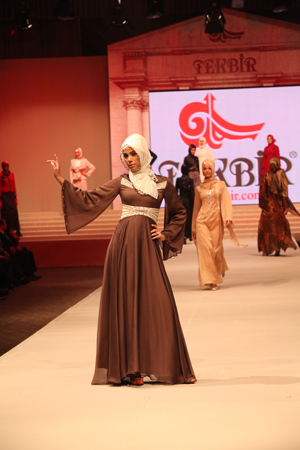
Tekbir Inc. fashion show (2011) featuring the 2012 winter collection. Tekbir is the leading veiling-fashion company of Turkey. photo by Banu Gökarıksel.
At the same time as the veil has been geopolitically scripted to symbolize the “Islamic threat,” the style of veiling has undergone a radical transformation and the veil has become a fashion object. This is partly motivated (and justified) by fashion designers and companies, as well as by veiled women themselves, and can be seen as a response to the negative image of the veil and an attempt to portray a pleasant, elegant, and modern appearance in veiling.
For example, in an interview I conducted in 2004, a veiling-fashion store manager in Istanbul explained that she purposefully chose hot pink and white polka dotted headscarves, and completely white attire for the sales assistants who worked at the store. With these trendy colors she wanted to distance her store, sales assistants, and products from the all black veil, which is associated by some with Islamic conservatism and extremism. Choosing bright colors, she explained, improves the image of veiled women in society.
Some women who wear fashionable styles of veiling in Turkey do so to intentionally distinguish themselves from the more fully veiled women who wear the all-enveloping and usually black (or dark colored) çarşaf or chador. In fact, some women my research partner Anna Secor (Professor of Geography, University of Kentucky) and I interviewed refer to women in çarşaf as extremely covered, and suspect that they may be carrying weapons or bombs underneath, instead of presenting themselves as more transparent and moderate.
Veiling-fashion, then, is also part of how Muslim women navigate the everyday geopolitics of “Islamic threat.” By wearing lighter colors and more ‘pleasing’ styles, Muslim women not only attempt to dispel the negative associations of the veil, but also to position themselves as fashion-conscious consumers, integrating into ‘modern’ society –as a profitable niche market, no less. In short, veiling-fashion works on multiple levels – aesthetically, discursively, and in the everyday practices of both its producers and consumers – both to accommodate and to challenge global geopolitical mappings that pit ‘Islam vs. the West.’
Fashion is often easily dismissed as trivial or superficial. It is commonly associated with constant change, surface appearance, and materiality; focusing on an aesthetic of visibility — seemingly unanchored by any moral considerations.
And yet fashion can also be evocative of individuality.
The veil, to many, is exactly the opposite of fashion and not necessarily about individuality. It is about stability, spirituality, and morality. Despite this perceived contradiction, a global fashion industry has emerged that produces and markets headscarves, overcoats, abayas, jilbabs, tunics, pants, long skirts, and other, increasingly diversified items of clothing.
Veiling styles are displayed on catwalks, in glossy catalogs, and on the pages of Muslim lifestyle magazines. Many Muslim women wear these fashionable veiling styles, blog about them, watch online videos to learn the latest trend in styling the scarf, and go to fashion shows.
While not all veiled Muslim women adopt such fashionable styles and many scrutinize the veil as a fashion object (including the very same women who wear such styles), the fashionable veil is a global phenomenon that is an undeniable part of the experience of veiling for Muslim women today.
Research by Carla Jones (Associate Professor of Anthropology at the University of Colorado, Boulder), Elizabeth Bucar (Associate Professor of Philosophy and Religion at Northeastern University), Anna Secor and me, looks at the significance of aesthetics and visuality for Muslim women’s veiling practices and piety.
We have all raised important questions about the links between the ethics and aesthetics of veiling and note there is a lot of ambivalence about the relationship between appearance and piety.
The aesthetic ideal of veiling-fashion is that of harmony. As my research with Secor on Turkey demonstrates, this becomes important in both signaling and resolving the ambivalence veiled women feel toward fashionable veiling styles.
By harmony we mean harmony between elements of the dress, harmony between appearance and conduct, and harmony between appearance and belief. Most of the veiled Muslim women who participated in our research considered incongruities of dress such as miniskirts, bright red lipstick, or colorful nail polish worn with headscarves aesthetic outrages, a critique that includes an ethical dimension. (This by no means indicates that this a universal belief among Muslim women. In Turkish veiling-fashion company catalogs and on the streets of Istanbul it is not rare to see veiled women with make-up, slim-cut pants, or nail polish.)
Indeed, whether a particular style is a sin against God or against aesthetics, we found, was often a blurry area. While upholding the ideal of harmony and linking physical beauty intimately to spiritual beauty, many women in our research also readily talked about their own failures to achieve the desired harmony. They often identified inconsistencies in the way other veiled women wear the headscarf, dress, or act as well.
Yet, even when research participants talked about such shortcomings, they continued to reference an ideal of harmony, seeking to combine inseparably the aesthetic and ethic of veiling-fashion. Many of the fashionably veiled women we interviewed saw themselves becoming pious Muslims through their engagement with both the aesthetic and ethic of veiling-fashion.
Watch Interview below with Banu Gökarıksel on veiling fashion and makeup in Turkey, Indonesia and Europe, and political stereotypes of the veil worldwide
Associate Professor of Anthropology Carla Jones’s research focuses on Indonesia, a country with the largest Muslim population in the world and a long history of Islam, but where veiling has only recently become common. At the conference Jones drew our attention to the edges of veiling, particularly the lace that women wear under the headscarf as a border between their face and the scarf. The fascinating history of lace is linked both to Europe and to traditional and postcolonial/national Indonesian clothing styles. This history helps us to situate the continuing popularity of lace in Muslim dress in Indonesia
Jones’s analysis showed the anxieties lace invokes in veiling. She identifies several reasons for these anxieties:
“Its material quality of both being present and not present, there and not there, allowed it to both conceal and reveal at the same time,” she said. “Politically, it was also a charged border object.”
The risk of using too much lace, and therefore coming across as too vain or superficial, is also something that her research participants discussed in great detail.
As she noted, there is constant questioning about veiling and suspicion about the role of lace. What is truly veiling? How does one’s style reflect her virtuous purity? Jones pointed to the difficulty of answering these questions since fashion and consumption are all about multiple and ever-changing meanings. There is never one truth. So it seems like it is this ambivalence that animates veiled women’s struggle of piety.
Liz Bucar meanwhile, implores us to think about the potential for something superficial (in visual culture) to potentially enact a “permanent revolution”. In her research she argues that visual culture is inherently ambiguous because images can have multiple meanings. This ambiguity, according to Bucar, enables veiled women to safeguard against critique: “since images must be interpreted by the viewer, an agent can claim that any specific meaning attributed her sartorial style, it proven too radical, is ‘untrue.’”
Bucar’s comparative analysis of veiling in Indonesia, Turkey, and Iran has much to offer in enhancing our understanding of veiling and its place specific forms and meanings. The visual differences are striking in this comparison. Bucar suggested, in her presentation, that stylistic innovations can oppose existing aesthetic and moral conventions. She locates visual culture between consensus and rebellion, “as a medium of tactical critique that still plays by ethical rules”.
By analyzing veiling through the lens of visual culture and fashion, the complex interactions between aesthetic and ethical concerns, between materialism and spirituality, and between consumer capitalism and Islam, are clear.
The Politics of the Veil in Sport
Homa Hoodfar’s research examines the politics of sports and the varying responses among Muslim communities to international sports organizations’ recent relaxation of dress codes to allow the headscarf. (UNC-Chapel Hill Professor of Asian Studies and Adjunct Professor of French & Francophone Studies Sahar Amer presented her paper, in her absence.)
In June 2012 FIFA announced that women could wear the ‘safe’ headscarf. While some Muslim activist communities especially in Western Europe celebrated this announcement, in Iran the reaction was mixed.
Hoodfar, Professor of Anthropology at Concordia University, Canada, explained the Iranian response in her paper by tracing the history of how “sport [became] an avenue for expressing opposition to [Islamic Republic’s] gender ideology and policies.”
Iranian women, Hoodfar showed, fought a long battle against the regime to be able to participate in sports. Finding legitimacy in Islamic teachings, Iranian women athletes argued for a woman’s right to participate in athletics. The emerging solution, accepted by the regime, was organizing the “Islamic Women’s Games.” (For more insight into dressing for the games listen to Rev. Welton Gaddy’s interview with Georgetown Professor Sarah Kureshi last summer on State of Belief radio.)
Iran hosted the games in 1993, 1997, 2001, and 2005. By 2007, Iranian women were active in 44 branches of sports, and in 18 of these they have achieved a level that can participate in international competitions.
Hoodfar’s research participants felt that through their perseverance they have opened up sport not only to women in Iran, but to pious Muslim women globally. Yet, she explained in her paper, the FIFA decision was problematic for Iranian women because it failed to acknowledge the cases in which the veil is imposed by the state and not always the choice of women athletes.
Veiling is Not Only in ‘Islam’
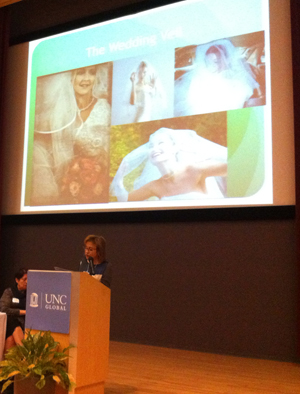
Marilia Marchetti, Professor of French and Francophone Literature at the University of Catania, Italy, presents her research on veiling practices. photo by Julie Poucher Harbin
Veiling is a practice that is not unique to Muslim women but is common in its various forms across many cultures and regions of the world. Marilia Marchetti’s presentation drew this point home when she showed images of veiling among conservative Catholic women in Italy, and pointed to photos of wedding veils.
One striking image that Marchetti, Professor of French and Francophone Literature at the University of Catania, Italy, showed was of women fully covered in black robes a church in Sardinia circa 1980. Even today when women visit the Vatican, they are required to cover their head and hair with scarves.
Marchetti questioned the neat separation of Italian culture and Catholicism from Muslim Arab cultures by emphasizing the historical presence of the latter and its influence on the former. She traced Italy’s relation to the Islamic world to the 7th century Byzantine Empire and to the period from 827 to 1061, when Southern Italy was under Islamic rule.
She noted that the influence of Arab and Muslim civilization on Italian culture is not limited to science, food, and language, but also includes cultural intermingling and intermarriages. A medieval Italian Catholic icon in which the Virgin Mary is seen wearing Arabic clothing showed the extent of such influence.
While Italy, unlike France, is rarely thought of as a context in which the veil is politicized, Marchetti’s research highlighted the emergence of stereotypes about the Muslim veil and how veiled Muslim women are challenging them.
Her conclusions — that veiling is part of Italian culture and that Italians are curious about Islam and the practice of veiling (this is also a recurrent theme in Italian orientalist paintings and travelogues)
Conclusions
It is possible to imagine a world in which Muslim women and the veil are not merely symbols of the Other.
The conference presentations and papers of Drake, Lservot, Marchetti, and Hoodfar effectively destabilized the depiction of the Muslim as the Other, as someone who is fundamentally different from ‘us.’ They provided representations of the veil and veiled women that do not conform to stereotypes.
They urged us to ask questions that go beyond the presumption of the veil as oppressive and instead encouraged shifting the focus to how women, veiled and non-veiled, are positioned in a complex web of power relations, neither completely liberated nor oppressed.
Such a view has the potential for formulating an inclusive feminist politics that is attentive to both differences and similarities that cut across various axes of identification.
Last, but certainly not least, rather than a frivolous topic, the linking of fashion to the practice of veiling, foregrounds how Muslim identities and pieties are formed today in capitalist and materialistic societies.
We must try harder to understand Muslim women’s formation of their identities, their ideals, pleasures, and desires and their ongoing struggles on the path of piety.
Banu Gökarıksel is Associate Professor of Geography at the University of North Carolina, Chapel Hill. Through the ethnographic and multi-method fieldwork research she has been conducting in Istanbul since 1996, she analyzes the formation of Muslim subjects, spaces, and commodities within the Turkish context where Islam, gender, and consumer capitalism are fiercely debated. She has published widely on the topic of veiling in geography journals and contributed to several edited books. She also co-edited a special issue of the “Journal of Middle East Women’s Studies” on “Marketing Muslim women: Muslim women, consumer capitalism, and the Islamic culture industry.” She is currently collaborating with Anna Secor (University of Kentucky) on a National Science Foundation-funded project that examines the production and consumption of veiling-fashion. She and Secor’s article —”The Veil, Desire, and the Gaze: Turning the Inside Out” is forthcoming in “Signs: Journal of Women in Culture and Society.” Research web site: http://veilingfashion.unc.edu/
ReOrienting the Veil conference organizers were Banu Gökarıksel; Sahar Amer, Asian Studies; Martine Antle, Department of Romance Languages, French and Francophone Studies; Juliane Hammer, Department of Religious Studies; Regina Higgins, Outreach Director of The Carolina Center for the Study of the Middle East and Muslim Civilizations; and Shai Tamari, Associate Director of the Carolina Center for the Study of the Middle East and Muslim Civilizations. Discussants included Ellen McLarney and miriam cooke (Asian and Middle Eastern Studies at Duke) and Claudia Koonz (emeritus, Department of History at Duke)
—
ReOrienting the Veil Conference in the Media:
Tolerate the Veil (Durham Herald Sun, Feb. 26, 2013)
Citations and Other Resources:
Banu Gökarıksel and Anna Secor, New Transnational Geographies of Islamism, Capitalism and Subjectivity: The Veiling-Fashion Industry in Turkey, 2009, Area, 41, 1, 6-18.
Banu Gökarıksel and Anna Secor, You can’t know how they are inside: The Ambivalence of Veiling and Discourses of the Other in Turkey, in Peter Hopkins, Lily Kong, and Elizabeth Olson eds. Religion and Place: Landscape, Politics, and Piety. 2013, pp.95-113. Springer Press: Dordrecht.
Banu Gökarıksel and Anna Secor, ‘Even I Was Tempted:’ The Moral Ambivalence and Ethical Practice of Veiling-Fashion in Turkey, Annals of the Association of American Geographers, 2012, 102, 4, 847-862. DOI:10.1080/00045608.2011.601221
Cooke, miriam (2007). The Muslimwoman. Contemporary Islam, vol 1, issue 2, pp. 136-154
MacMaster, N. (2010). Burning the veil: the Algerian War and the ‘emancipation’ of Muslim women, 1954-1962. Manchester, UK: Manchester University Press.
Nussbaum, M. (2010). Veiled Threats? Opinionator, Exclusive Online Commentary from the Times, 11 July.
Scott, J. (2007). The Politics of the Veil. Princeton, N.J.: Princeton University Press.
Fluri, Jennifer. Armored peacocks and proxy bodies: gender geopolitics in aid/development spaces of Afghanistan. Gender, Place & Culture: A Journal of Feminist Geography, vol. 18, issue 4. Volume 18, Issue 4, pp 519-536.
Abu-Lughod, Lila. (2002) Do Muslim Women Really Need Saving? Anthropological Reflections on Cultural Relativism and Its Others. Ethics Forum: September 11 and Ethnographic Responsibility.


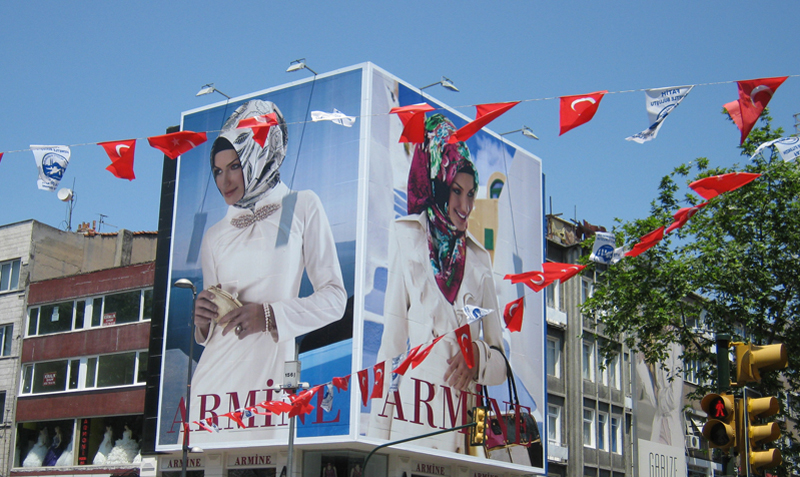
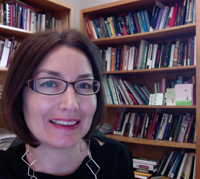
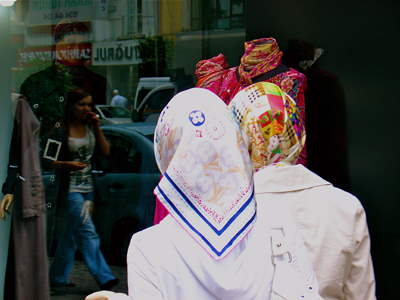
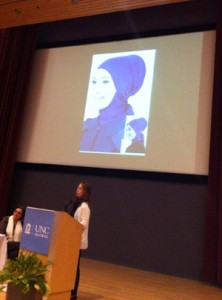
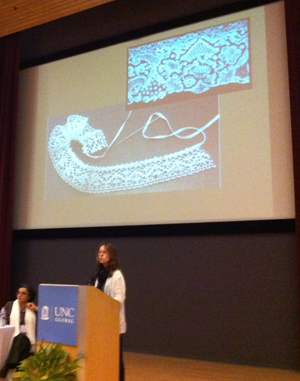
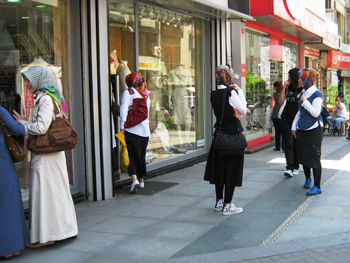

 © 2025 All Rights Reserved
© 2025 All Rights Reserved